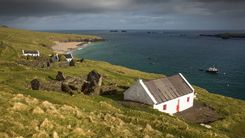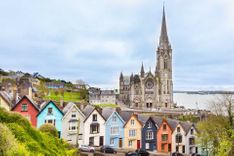Average prices per night
Ireland isn’t cheap, but you can still find good value if you know where to look. On average, expect to pay $55-85 (€50-80) for a basic private room, $110-170 (€100-160) for a solid mid-range hotel, and $215+ (€200+) for boutique or luxury stays. Dorm beds in hostels start at $27 (€25), while glamping pods and eco-lodges tend to sit around $140 (€130), especially in scenic spots like Kerry or Connemara.
- Prices peak in summer (June to August), especially in tourist-heavy areas like Dublin, Galway, and anywhere along the Wild Atlantic Way. Accommodation fills up fast around festivals, long weekends, and school holidays — book ahead unless you like last-minute panic browsing.
- Spring and autumn (April-May and September-October) offer slightly lower rates, and you’ll still get decent weather (by Irish standards). Winter is cheaper overall, but some rural B&Bs and coastal hotels shut up shop entirely, so check ahead.
Breakfast is usually included in mid-range and up — and not just toast. We're talking full Irish: eggs, bacon, sausage, tomato, and enough tea to power a small village. Cheaper spots might skip it, or charge extra. And while you won’t get hit with random surcharges for air-con (you probably won’t need it), keep an eye on parking fees and late check-out costs in cities.
Where to stay in Ireland: Best areas by region
Ireland may be compact, but where you stay shapes everything — from how much Guinness you drink to how many sheep block your road. Whether you’re into cliff walks, pub crawls, or castle stays, picking the right area makes all the difference.
Dublin
The capital is vibrant, sometimes chaotic, and never short on character. Where to stay in Dublin matters — especially if you plan on sleeping.
Temple Bar and City Centre are where the action is. It’s all cobbled lanes, live music, and pubs that spill out onto the street. Great for nightlife and walkability, less great for peace and quiet (or your wallet).
Portobello and Ranelagh offer a slower pace. These leafy suburbs are within walking distance of the center, packed with brunch spots, and full of boutique guesthouses. Stylish but not smug.
Smithfield and the Liberties are more up-and-coming. Expect modern apartments, cool hostels, and a mix of gritty history and hipster cafés. A solid pick if you want real Dublin, not just postcard Dublin.
Galway
Galway is artsy, compact, and always up for a trad session. You can’t really go wrong, but different corners suit different moods.
City Centre (around Eyre Square and the Latin Quarter) puts you in the middle of it all. Great food, live music every night, and enough pub options to test your stamina.
Salthill is Galway’s seaside stretch. It’s walkable from the city and good for families or beachy downtime. Think sea breezes, ice cream vans, and B&Bs with bay views.
Claddagh and West End are more low-key, with easy access to both the city and the coast. Quieter at night, with solid mid-range stays and fewer tourist crowds.
Dingle Peninsula
If you want Irish landscapes, live music, and locals who’ll out-chat you at the bar, Dingle’s the place.
Dingle Town is the hub. It’s colorful, compact, and full of charm. Stay here for pubs, music, seafood, and access to the Slea Head Drive.
Ventry or Ballyferriter are quieter coastal villages a short drive away. Great if you want sea views and slower mornings — but you’ll need a car.









